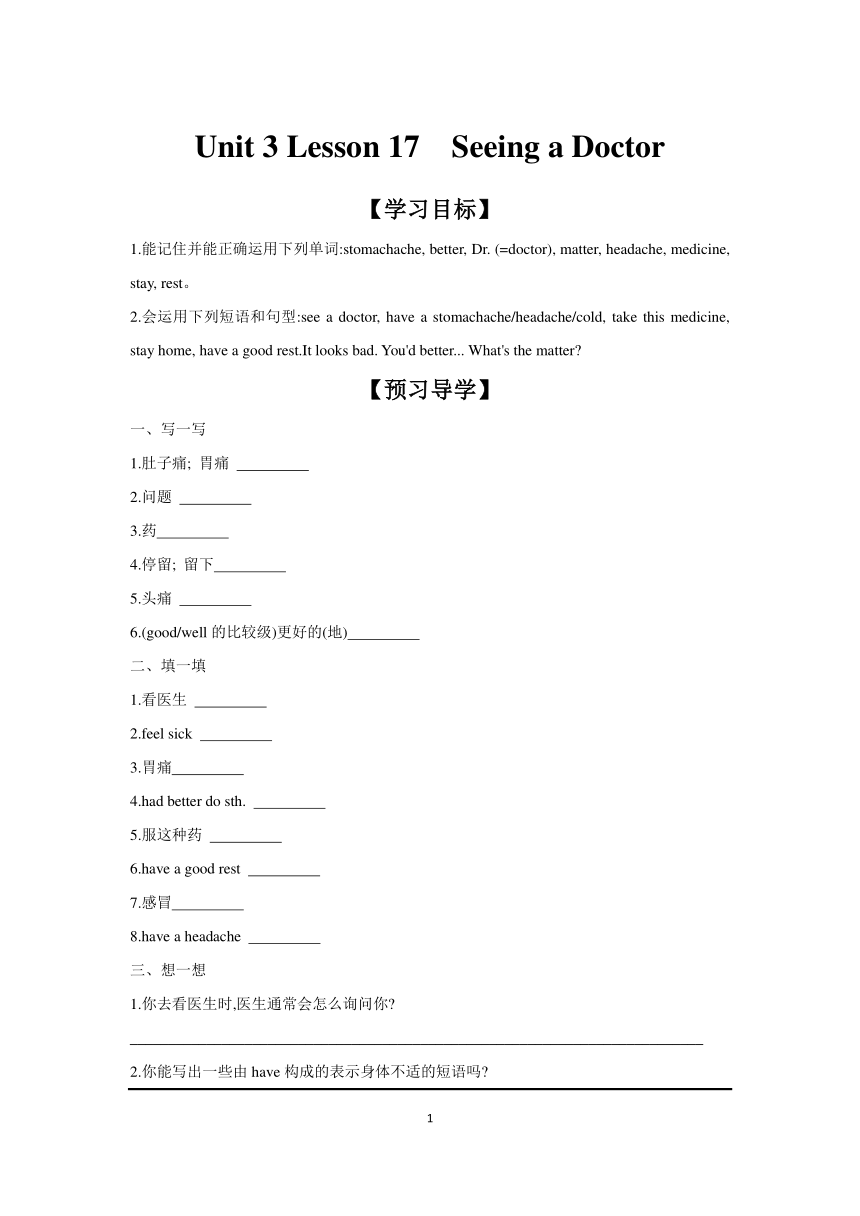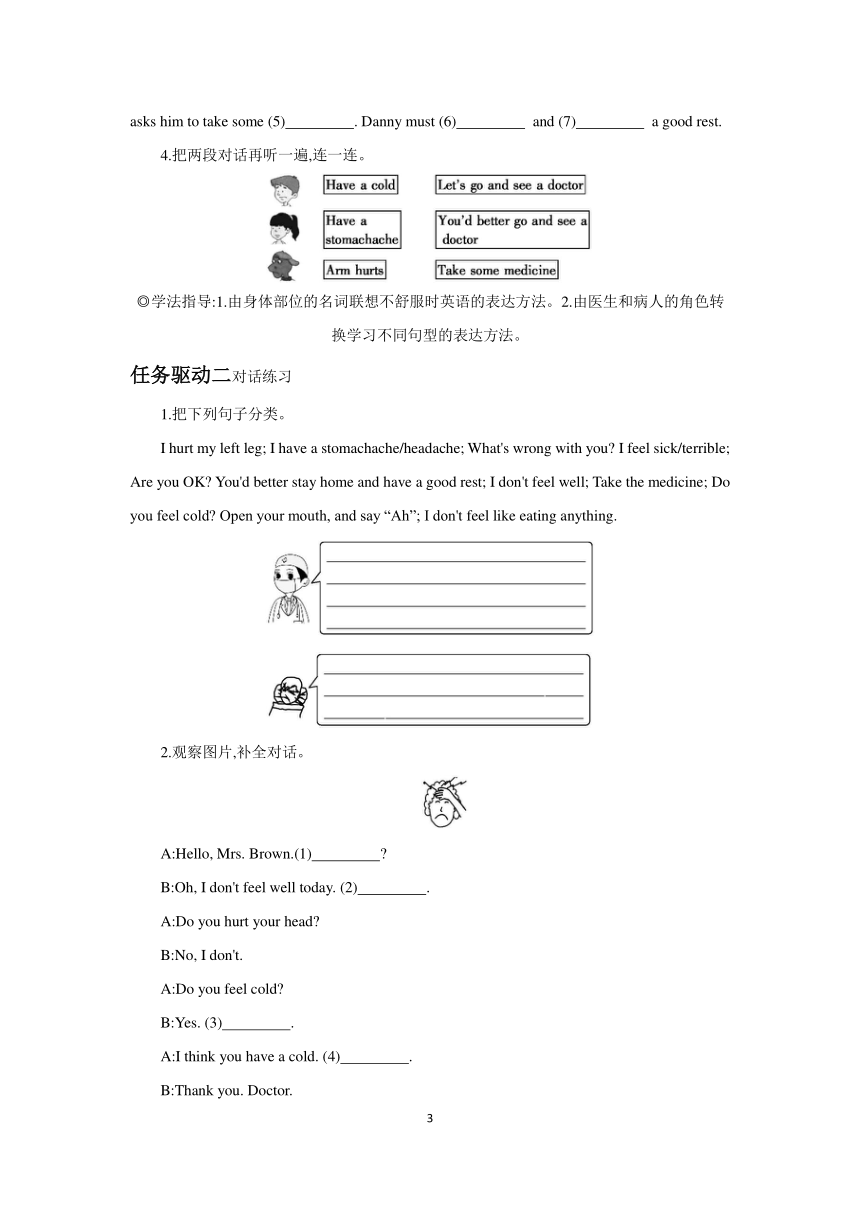冀教版七年级上册Unit 3 Lesson 17 Seeing a Doctor 学案(含答案)
文档属性
| 名称 | 冀教版七年级上册Unit 3 Lesson 17 Seeing a Doctor 学案(含答案) |  | |
| 格式 | docx | ||
| 文件大小 | 227.3KB | ||
| 资源类型 | 教案 | ||
| 版本资源 | 冀教版 | ||
| 科目 | 英语 | ||
| 更新时间 | 2024-02-29 11:49:37 | ||
图片预览



文档简介
Unit 3 Lesson 17 Seeing a Doctor
【学习目标】
1.能记住并能正确运用下列单词:stomachache, better, Dr. (=doctor), matter, headache, medicine, stay, rest。
2.会运用下列短语和句型:see a doctor, have a stomachache/headache/cold, take this medicine, stay home, have a good rest.It looks bad. You'd better... What's the matter
【预习导学】
一、写一写
1.肚子痛; 胃痛
2.问题
3.药
4.停留; 留下
5.头痛
6.(good/well的比较级)更好的(地)
二、填一填
1.看医生
2.feel sick
3.胃痛
4.had better do sth.
5.服这种药
6.have a good rest
7.感冒
8.have a headache
三、想一想
1.你去看医生时,医生通常会怎么询问你
___________________________________________________________________________
2.你能写出一些由have构成的表示身体不适的短语吗
【答案】
一、
1.stomachache 2.matter 3.medicine 4.stay 5.headache 6.better
二、
1.see a doctor
2.感到难受/不舒服
3.have a stomachache
4.最好做某事
5.take this medicine
6.好好休息
7.have a cold
8.头痛
三、
1.What's wrong What's the matter Are you OK
2.have a headache,have a stomachache, have a toothache, have a cold, have a backache
【合作探究】
任务驱动一听力训练
1.根据汉语意思填空。
2.听本课时Are you OK 对话的录音,回答下列问题。
(1)Whose arm hurts
___________________________________________________________________________
(2)Why does Wang Mei feel sick
___________________________________________________________________________
(3)What should Wang Mei do
___________________________________________________________________________
3.听本课时You have a cold.对话的录音,完成短文填空。
Danny feels (1) . What's the matter with him Oh, he has a (2) and he feels very cold. He goes to see a (3) . The doctor says he has a (4) . Dr. Green asks him to take some (5) . Danny must (6) and (7) a good rest.
4.把两段对话再听一遍,连一连。
◎学法指导:1.由身体部位的名词联想不舒服时英语的表达方法。2.由医生和病人的角色转换学习不同句型的表达方法。
任务驱动二对话练习
1.把下列句子分类。
I hurt my left leg; I have a stomachache/headache; What's wrong with you I feel sick/terrible; Are you OK You'd better stay home and have a good rest; I don't feel well; Take the medicine; Do you feel cold Open your mouth, and say “Ah”; I don't feel like eating anything.
2.观察图片,补全对话。
A:Hello, Mrs. Brown.(1)
B:Oh, I don't feel well today. (2) .
A:Do you hurt your head
B:No, I don't.
A:Do you feel cold
B:Yes. (3) .
A:I think you have a cold. (4) .
B:Thank you. Doctor.
3.假如你肚子疼,同伴扮演医生,表演对话。
A:Hi, Tina. (1)
B:I have a stomachache.
A:(2) .
B:Thank you. Doctor.
◎学法指导:操练对话时注意说话的语气、表情和动作需符合病人的状态,让表演更真实哦。
【答案】
任务驱动一
1.
2.(1)Jim's (arm).
(2)Because she has a stomachache.
(3)She had better go and see a doctor.
3.(1)sick (2)headache (3)doctor (4)cold (5)medicine (6)stay home (7)have
4.
任务驱动二
1.
2.(1)What's the matter
(2)I have a headache
(3)I feel a little cold
(4)Take this medicine, drink a lot of water and have a good rest at home
3.(1)What's wrong/the matter with you
(2)Take this medicine. Lie down and have a rest. You'll be better soon
【知识超市】
[命题点一]I have a headache. 我头痛。
这是患病或身体不舒服的一种表达方式。have 在此表示“患病”之意。常用句型:
1.主语+have/has+a+病症
例如:Jim has a cold.吉姆感冒了。
2.主语+have/has+a+身体部位-ache,常与表示身体部位的名词合成另外一个新词, 表示身体某部位疼痛。
例如:He has a headache.他头疼。
3.身体部位+hurt(s)
hurt 用作动词,意为“疼;痛”,表达某一具体位置的疼痛。例如:My back hurts.我的背疼。
【拓展】由have构成的表示身体不适的短语:
have a cold 感冒 have a backache 背痛
have a stomachache 肚子痛
have a toothache 牙痛 have a headache 头痛
have a fever 发烧
◎学法指导:ache意为“疼痛”。
head + ache = headache 头痛
stomach + ache = stomachache 胃痛
tooth + ache = toothache 牙痛
对点自测
单项选择。
( )1.Do you have headache
A.a B.an C.不填 D.the
( )2.—What's the matter
—I have .
A.a stomach B.a stomachache C.stomachs D.stomachache
[命题点二]You'd better go and see a doctor, Wang Mei.王梅,你最好去看医生。
had better do sth. 是固定搭配, 意为“最好做某事”,其后接动词原形用来表示建议;其否定形式是had better not do sth.,意为“最好不要做某事”。例如:
You'd better not watch TV every day.你最好不要天天看电视。
对点自测
单项选择。
( )You'd better there.
don't go B.not to go C.aren't go D.not go
【答案】
命题点一
对点自测
1.A 2.B
命题点二
对点自测
D
2
【学习目标】
1.能记住并能正确运用下列单词:stomachache, better, Dr. (=doctor), matter, headache, medicine, stay, rest。
2.会运用下列短语和句型:see a doctor, have a stomachache/headache/cold, take this medicine, stay home, have a good rest.It looks bad. You'd better... What's the matter
【预习导学】
一、写一写
1.肚子痛; 胃痛
2.问题
3.药
4.停留; 留下
5.头痛
6.(good/well的比较级)更好的(地)
二、填一填
1.看医生
2.feel sick
3.胃痛
4.had better do sth.
5.服这种药
6.have a good rest
7.感冒
8.have a headache
三、想一想
1.你去看医生时,医生通常会怎么询问你
___________________________________________________________________________
2.你能写出一些由have构成的表示身体不适的短语吗
【答案】
一、
1.stomachache 2.matter 3.medicine 4.stay 5.headache 6.better
二、
1.see a doctor
2.感到难受/不舒服
3.have a stomachache
4.最好做某事
5.take this medicine
6.好好休息
7.have a cold
8.头痛
三、
1.What's wrong What's the matter Are you OK
2.have a headache,have a stomachache, have a toothache, have a cold, have a backache
【合作探究】
任务驱动一听力训练
1.根据汉语意思填空。
2.听本课时Are you OK 对话的录音,回答下列问题。
(1)Whose arm hurts
___________________________________________________________________________
(2)Why does Wang Mei feel sick
___________________________________________________________________________
(3)What should Wang Mei do
___________________________________________________________________________
3.听本课时You have a cold.对话的录音,完成短文填空。
Danny feels (1) . What's the matter with him Oh, he has a (2) and he feels very cold. He goes to see a (3) . The doctor says he has a (4) . Dr. Green asks him to take some (5) . Danny must (6) and (7) a good rest.
4.把两段对话再听一遍,连一连。
◎学法指导:1.由身体部位的名词联想不舒服时英语的表达方法。2.由医生和病人的角色转换学习不同句型的表达方法。
任务驱动二对话练习
1.把下列句子分类。
I hurt my left leg; I have a stomachache/headache; What's wrong with you I feel sick/terrible; Are you OK You'd better stay home and have a good rest; I don't feel well; Take the medicine; Do you feel cold Open your mouth, and say “Ah”; I don't feel like eating anything.
2.观察图片,补全对话。
A:Hello, Mrs. Brown.(1)
B:Oh, I don't feel well today. (2) .
A:Do you hurt your head
B:No, I don't.
A:Do you feel cold
B:Yes. (3) .
A:I think you have a cold. (4) .
B:Thank you. Doctor.
3.假如你肚子疼,同伴扮演医生,表演对话。
A:Hi, Tina. (1)
B:I have a stomachache.
A:(2) .
B:Thank you. Doctor.
◎学法指导:操练对话时注意说话的语气、表情和动作需符合病人的状态,让表演更真实哦。
【答案】
任务驱动一
1.
2.(1)Jim's (arm).
(2)Because she has a stomachache.
(3)She had better go and see a doctor.
3.(1)sick (2)headache (3)doctor (4)cold (5)medicine (6)stay home (7)have
4.
任务驱动二
1.
2.(1)What's the matter
(2)I have a headache
(3)I feel a little cold
(4)Take this medicine, drink a lot of water and have a good rest at home
3.(1)What's wrong/the matter with you
(2)Take this medicine. Lie down and have a rest. You'll be better soon
【知识超市】
[命题点一]I have a headache. 我头痛。
这是患病或身体不舒服的一种表达方式。have 在此表示“患病”之意。常用句型:
1.主语+have/has+a+病症
例如:Jim has a cold.吉姆感冒了。
2.主语+have/has+a+身体部位-ache,常与表示身体部位的名词合成另外一个新词, 表示身体某部位疼痛。
例如:He has a headache.他头疼。
3.身体部位+hurt(s)
hurt 用作动词,意为“疼;痛”,表达某一具体位置的疼痛。例如:My back hurts.我的背疼。
【拓展】由have构成的表示身体不适的短语:
have a cold 感冒 have a backache 背痛
have a stomachache 肚子痛
have a toothache 牙痛 have a headache 头痛
have a fever 发烧
◎学法指导:ache意为“疼痛”。
head + ache = headache 头痛
stomach + ache = stomachache 胃痛
tooth + ache = toothache 牙痛
对点自测
单项选择。
( )1.Do you have headache
A.a B.an C.不填 D.the
( )2.—What's the matter
—I have .
A.a stomach B.a stomachache C.stomachs D.stomachache
[命题点二]You'd better go and see a doctor, Wang Mei.王梅,你最好去看医生。
had better do sth. 是固定搭配, 意为“最好做某事”,其后接动词原形用来表示建议;其否定形式是had better not do sth.,意为“最好不要做某事”。例如:
You'd better not watch TV every day.你最好不要天天看电视。
对点自测
单项选择。
( )You'd better there.
don't go B.not to go C.aren't go D.not go
【答案】
命题点一
对点自测
1.A 2.B
命题点二
对点自测
D
2
同课章节目录
- Unit 1 School and friends
- Lesson 1 Hello!
- Lesson 2 Teacher and Students
- Lesson 3 Welcome to Our School
- Lesson 4 What Is It?
- Lesson 5 May I Have a Book?
- Lesson 6 Things for School
- Unit 2 Colours and Clothes
- Lesson 7 Jenny's New Skirt
- Lesson 8 Danny's Favourit Colou
- Lesson 9 Whose Coat Is This?
- Lesson 10 Clothes for a Cold Day
- Lesson 11 Clothes around the World
- Lesson 12 Let's Go Shopping!
- Unit 3 Body Parts and Feelings
- Lesson 13 Body Parts
- Lesson 14 Colours and Feelings
- Lesson 15 Tall or Short
- Lesson 16 Happy or Sad
- Lesson 17 Seeing a Docto
- Lesson 18 We All Look Different!
- Unit 4 Food and Restaurants
- Lesson 19 Time for Breakfast!
- Lesson 20 I Like the Supermarket!
- Lesson 21 At the Market
- Lesson 22 In the Restaurant
- Lesson 23 The Corner Store
- Lesson 24 Eat Good Food!
- Unit 5 Family and Home
- Lesson 25 Jenny's Family
- Lesson 26 Li Ming's Family
- Lesson 27 Danny at Home
- Lesson 28 A Family Picnic
- Lesson 29 A Birthday Card
- Lesson 30 Grandma's Birthday Party
- Unit 6 Let's Go!
- Lesson 31 Let's Go to the Bookstore!
- Lesson 32 At the Supermarket
- Lesson 33 Let's Go to the Zoo!
- Lesson 34 On the Farm
- Lesson 35 Let's Go to the Museum!
- Lesson 36 Let's Go to the Movie Theatre!
- Unit 7 Days and Months
- Lesson 37 Seasons and Weathe
- Lesson 38 Nick's Busy Month
- Lesson 39 A Class Calenda
- Lesson 40 When Is Your Birthday?
- Lesson 41 Holidays
- Lesson 42 Happy Holidays!
- Unit 8 Countries around the world
- Lesson 43 Directions
- Lesson 44 Jack's Goodbye Party
- Lesson 45 China
- Lesson 46 Canada and the U.S.
- Lesson 47 The U.K. and Australia
- Lesson 48 English-Speaking Countries
